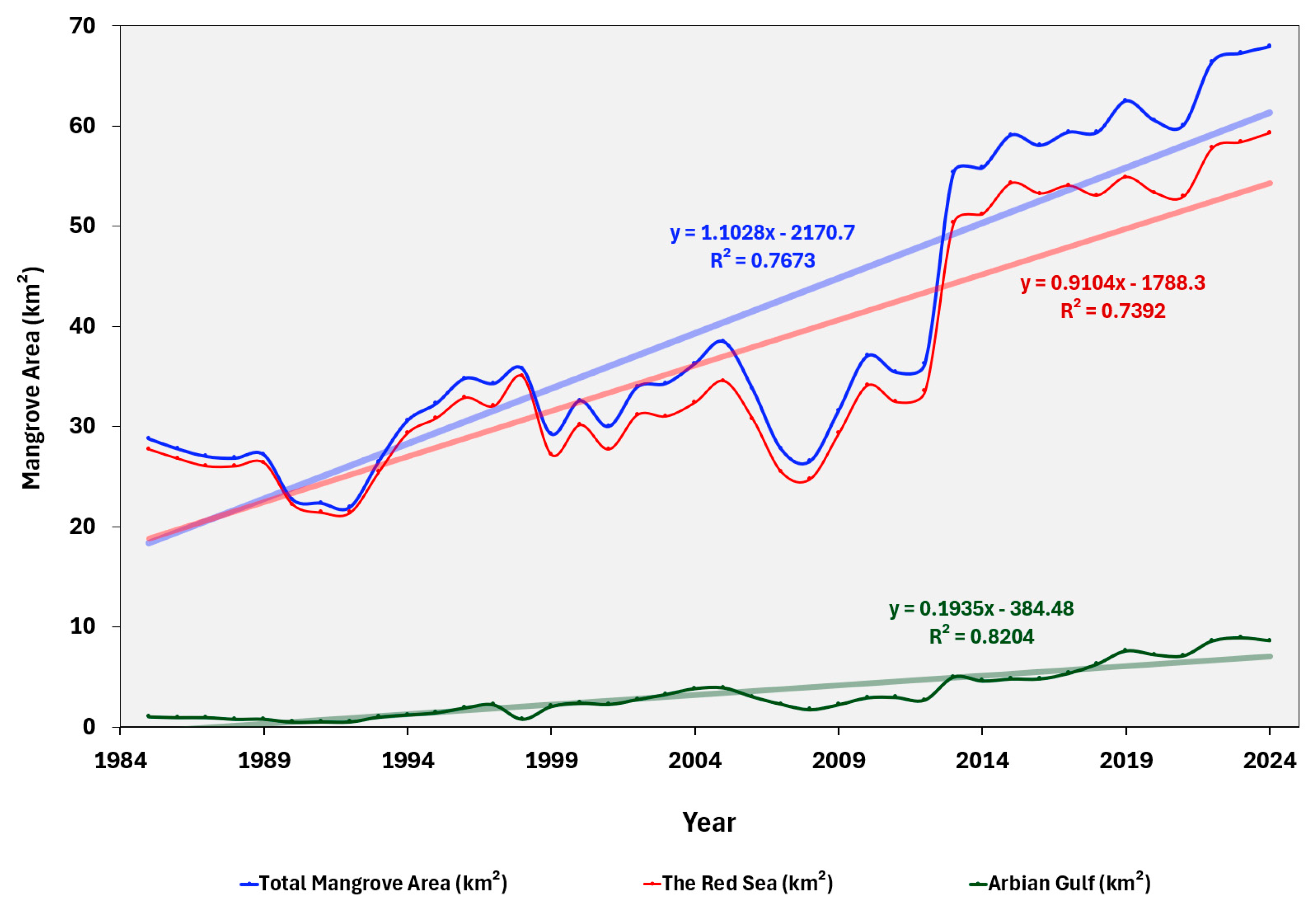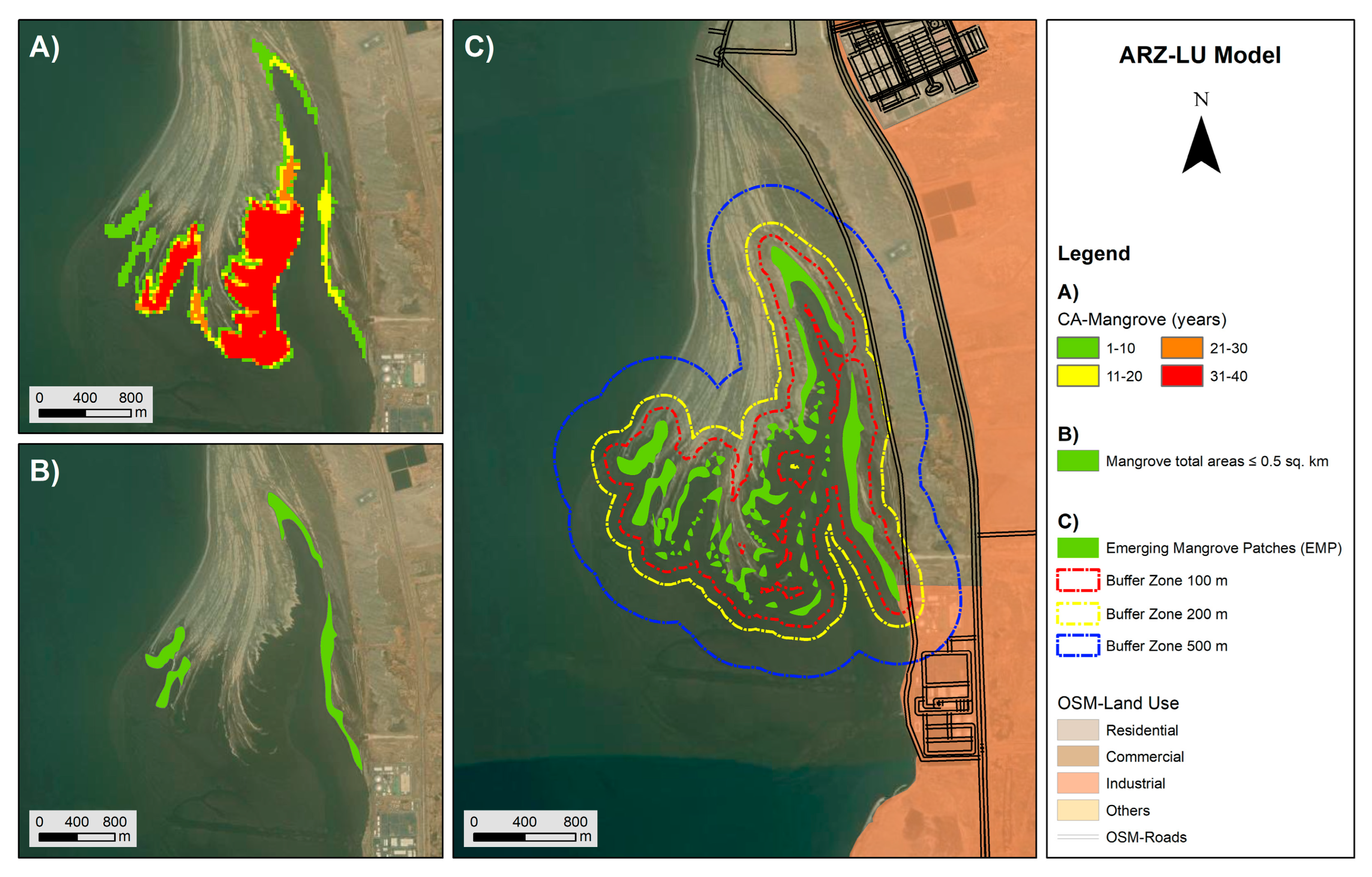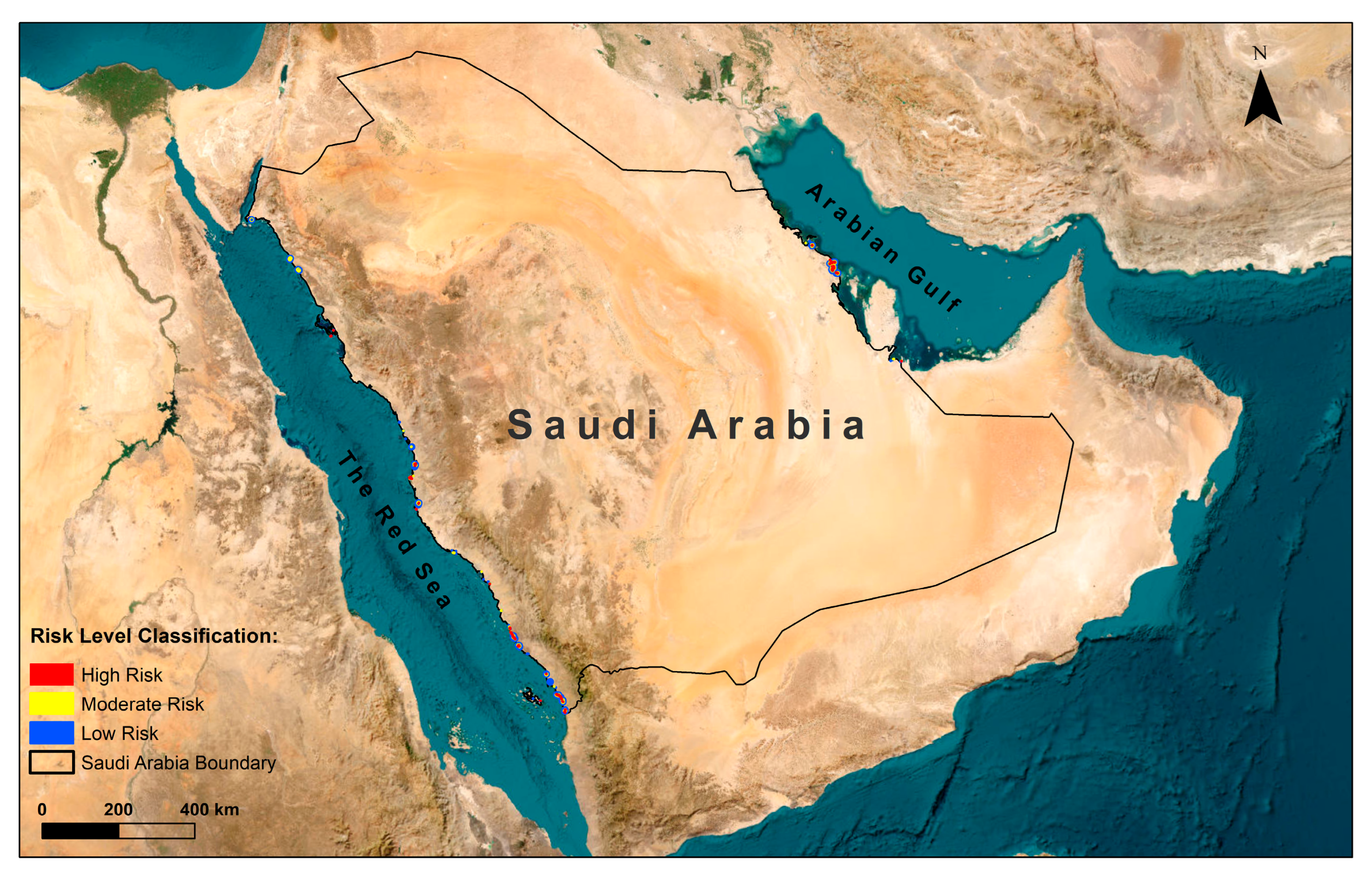Geospatial Analysis of Patterns and Trends of Mangrove Forest in Saudi Arabia: Identifying At-Risk Zone-Based Land Use
Abstract
1. Introduction
2. Study Area and Methods
2.1. Study Area
2.2. Data and Pre-Processing
2.2.1. Data Collection
2.2.2. Pre-Processing of Mangrove Mapping
2.3. Mangrove Data Processing
2.3.1. Training Data
2.3.2. Random Forest Algorithm for Mangrove Classification
2.3.3. Estimating the Accuracy for Mangrove Forest
2.4. At-Risk Zone-Based Land Use (ARZ-LU) Model
3. Results
3.1. Accuracy Assessment for the Annual Classification Maps
3.2. Characteristics of Mangrove Classification Results
3.3. Multitemporal Mangrove Cover Change
3.4. Identifying At-Risk Zones Based Land Use (ARZ-LU)
4. Discussion
5. Conclusions
Funding
Institutional Review Board Statement
Informed Consent Statement
Data Availability Statement
Acknowledgments
Conflicts of Interest
References
- Li, W.; El-Askary, H.; Qurban, M.A.; Li, J.; ManiKandan, K.P.; Piechota, T. Using Multi-Indices Approach to Quantify Mangrove Changes over the Western Arabian Gulf along Saudi Arabia Coast. Ecol. Indic. 2019, 102, 734–745. [Google Scholar] [CrossRef]
- Kumar, A.; Khan, M.A.; Muqtadir, A. Distribution of Mangroves along the Red Sea Coast of the Arabian Peninsula: Part-I: The Northern Coast of Western Saudi Arabia. Earth Sci. India 2010, 3, 28–42. [Google Scholar]
- Blanco-Sacristán, J.; Johansen, K.; Duarte, C.M.; Daffonchio, D.; Hoteit, I.; McCabe, M.F. Mangrove Distribution and Afforestation Potential in the Red Sea. Sci. Total Environ. 2022, 843, 157098. [Google Scholar] [CrossRef]
- Aye, W.N.; Wen, Y.; Marin, K.; Thapa, S.; Tun, A.W. Contribution of Mangrove Forest to the Livelihood of Local Communities in Ayeyarwaddy Region, Myanmar. Forests 2019, 10, 414. [Google Scholar] [CrossRef]
- Leal, M.; Spalding, M.D. The State of the World’s Mangroves. 2022. Available online: https://www.mangrovealliance.org/wp-content/uploads/2024/09/SOWM-2024-HR-1.pdf (accessed on 17 February 2024).
- Turschwell, M.P.; Tulloch, V.J.D.; Sievers, M.; Pearson, R.M.; Andradi-Brown, D.A.; Ahmadia, G.N.; Connolly, R.M.; Bryan-Brown, D.; Lopez-Marcano, S.; Adame, M.F.; et al. Multi-Scale Estimation of the Effects of Pressures and Drivers on Mangrove Forest Loss Globally. Biol. Conserv. 2020, 247, 108637. [Google Scholar] [CrossRef]
- United Nations Mangroves for Sustainable Development. Available online: https://unric.org/en/mangroves-for-sustainable-development/ (accessed on 16 February 2024).
- United Nations The Global Sustainable Development Report 2023. Available online: https://sdgs.un.org/gsdr/gsdr2023 (accessed on 16 February 2024).
- Saudi Climate Vision Championing Climate Action at Home and Abroad. Available online: https://www.sgi.gov.sa/saudi-climate-vision/?csrt=1643733478985877176 (accessed on 16 February 2024).
- El-Jhany, L.I. Present Status and Degredation Trends of Mangrove Forests on the Southern Red Sea Coast of Saudi Arabia. Am.-Eurasian J. Agric. Environ. Sci. 2009, 6, 328–340. [Google Scholar]
- Mohan, M.; Dutta Roy, A.; Montenegro, J.F.; Watt, M.S.; Burt, J.A.; Shapiro, A.; Ouerfelli, D.; Daniel, R.; de-Miguel, S.; Ali, T.; et al. Mangrove Forest Regeneration Age Map and Drivers of Restoration Success in Gulf Cooperation Council Countries from Satellite Imagery. Remote Sens. Appl. 2024, 36, 101345. [Google Scholar] [CrossRef]
- Aljahdali, M.O.; Munawar, S.; Khan, W.R. Monitoring Mangrove Forest Degradation and Regeneration: Landsat Time Series Analysis of Moisture and Vegetation Indices at Rabigh Lagoon, Red Sea. Forests 2021, 12, 52. [Google Scholar] [CrossRef]
- Almahasheer, H.; Al-Taisan, W.; Mohamed, M.K. Mangrove Deterioration in Tarut Bay on the Eastern Province of the Kingdom of Saudi Arabia. Pakhtunkhwa J. Life Sci. 2013, 1, 49–50. [Google Scholar]
- Almahasheer, H. Spatial Coverage of Mangrove Communities in the Arabian Gulf. Environ. Monit. Assess. 2018, 190, 85. [Google Scholar] [CrossRef]
- Yaseen, R.A.S. Study of Mangroves along with the Application of Remote Sensing and Geographical Information Systems (GIS), Within the Borders of National Prawn Company; King Abdulaziz University: Jeddah, Saudi Arabia, 2011. [Google Scholar]
- Saoum, M.R.; Sarkar, S.K. Monitoring Mangrove Forest Change and Its Impacts on the Environment. Ecol. Indic. 2024, 159, 111666. [Google Scholar] [CrossRef]
- Christensen, S.M.; Tarp, P.; Hjortsø, C.N. Mangrove Forest Management Planning in Coastal Buffer and Conservation Zones, Vietnam: A Multimethodological Approach Incorporating Multiple Stakeholders. Ocean Coast. Manag. 2008, 51, 712–726. [Google Scholar] [CrossRef]
- Luijendijk, A.P.; Kras, E.; Dagalaki, V.; Morelissen, R.; Hoteit, I.; Ranasinghe, R. Regime Shifts in Future Shoreline Dynamics of Saudi Arabia. Front. Mar. Sci. 2022, 8, 798657. [Google Scholar] [CrossRef]
- GEOSA Official Map of the Kingdom of Saudi Arabia. Available online: https://www.geosa.gov.sa/Documents/Maps/2023/2m_Eng_11ED.pdf (accessed on 16 February 2024).
- El-Rawy, M.; Batelaan, O.; Al-Arifi, N.; Alotaibi, A.; Abdalla, F.; Gabr, M. Climate Change Impacts on Water Resources in Arid and Semi-Arid Regions: A Case Study in Saudi Arabia. Water 2023, 15, 606. [Google Scholar] [CrossRef]
- CCKP Current Climate: Climatology, Trends and Variability. Available online: https://climateknowledgeportal.worldbank.org/watershed/92/climate-data-historical (accessed on 16 February 2024).
- Aljaddani, A.H.; Song, X.-P.; Zhu, Z. Characterizing the Patterns and Trends of Urban Growth in Saudi Arabia’s 13 Capital Cities Using a Landsat Time Series. Remote Sens. 2022, 14, 2382. [Google Scholar] [CrossRef]
- Farr, T.G.; Rosen, P.A.; Caro, E.; Crippen, R.; Duren, R.; Hensley, S.; Kobrick, M.; Paller, M.; Rodriguez, E.; Roth, L.; et al. The Shuttle Radar Topography Mission. Rev. Geophys. 2007, 45. [Google Scholar] [CrossRef]
- Bunting, P.; Rosenqvist, A.; Hilarides, L.; Lucas, R.M.; Thomas, N.; Tadono, T.; Worthington, T.A.; Spalding, M.; Murray, N.J.; Rebelo, L.-M. Global Mangrove Extent Change 1996–2020: Global Mangrove Watch Version 3.0. Remote Sens. 2022, 14, 3657. [Google Scholar] [CrossRef]
- NCVC Mangrove Database. Available online: https://ncvc.gov.sa/ar/digitalKnowledge/open-data/Pages/default.aspx (accessed on 11 May 2023).
- OpenStreetMap GCC States. Available online: https://download.geofabrik.de/asia/gcc-states.html (accessed on 1 February 2025).
- Gorelick, N.; Hancher, M.; Dixon, M.; Ilyushchenko, S.; Thau, D.; Moore, R. Google Earth Engine: Planetary-Scale Geospatial Analysis for Everyone. Remote Sens. Environ. 2017, 202, 18–27. [Google Scholar] [CrossRef]
- Ruan, L.; Yan, M.; Zhang, L.; Fan, X.; Yang, H. Spatial-Temporal NDVI Pattern of Global Mangroves: A Growing Trend during 2000–2018. Sci. Total Environ. 2022, 844, 157075. [Google Scholar] [CrossRef]
- Mondal, B.K.; Mahata, S.; Basu, T.; Das, R.; Patra, R.; Abdelrahman, K.; Fnais, M.S.; Praharaj, S. Analysis of the Post-Cyclonic Physical Flood Susceptibility and Changes of Mangrove Forest Area Using Multi-Criteria Decision-Making Process and Geospatial Analysis in Indian Sundarbans. Atmosphere 2024, 15, 432. [Google Scholar] [CrossRef]
- Chen, J.; Wang, Y.; Wang, J.; Zhang, Y.; Xu, Y.; Yang, O.; Zhang, R.; Wang, J.; Wang, Z.; Lu, F.; et al. The Performance of Landsat-8 and Landsat-9 Data for Water Body Extraction Based on Various Water Indices: A Comparative Analysis. Remote Sens. 2024, 16, 1984. [Google Scholar] [CrossRef]
- Fu, B.; He, X.; Yao, H.; Liang, Y.; Deng, T.; He, H.; Fan, D.; Lan, G.; He, W. Comparison of RFE-DL and Stacking Ensemble Learning Algorithms for Classifying Mangrove Species on UAV Multispectral Images. Int. J. Appl. Earth Obs. Geoinf. 2022, 112, 102890. [Google Scholar] [CrossRef]
- Chan-Bagot, K.; Herndon, K.E.; Puzzi Nicolau, A.; Martín-Arias, V.; Evans, C.; Parache, H.; Mosely, K.; Narine, Z.; Zutta, B. Integrating SAR, Optical, and Machine Learning for Enhanced Coastal Mangrove Monitoring in Guyana. Remote Sens. 2024, 16, 542. [Google Scholar] [CrossRef]
- Raj, N.; Pasfield-Neofitou, S. Assessment and Prediction of Sea Level and Coastal Wetland Changes in Small Islands Using Remote Sensing and Artificial Intelligence. Remote Sens. 2024, 16, 551. [Google Scholar] [CrossRef]
- Breiman, L. Random Forests. Mach. Learn. 2001, 45, 5–32. [Google Scholar] [CrossRef]
- Pande, C.B.; Srivastava, A.; Moharir, K.N.; Radwan, N.; Mohd Sidek, L.; Alshehri, F.; Pal, S.C.; Tolche, A.D.; Zhran, M. Characterizing Land Use/Land Cover Change Dynamics by an Enhanced Random Forest Machine Learning Model: A Google Earth Engine Implementation. Environ. Sci. Eur. 2024, 36, 84. [Google Scholar] [CrossRef]
- Teluguntla, P.; Thenkabail, P.S.; Oliphant, A.; Xiong, J.; Gumma, M.K.; Congalton, R.G.; Yadav, K.; Huete, A. A 30-m Landsat-Derived Cropland Extent Product of Australia and China Using Random Forest Machine Learning Algorithm on Google Earth Engine Cloud Computing Platform. ISPRS J. Photogramm. Remote Sens. 2018, 144, 325–340. [Google Scholar] [CrossRef]
- Aziz, G.; Minallah, N.; Saeed, A.; Frnda, J.; Khan, W. Remote Sensing Based Forest Cover Classification Using Machine Learning. Sci. Rep. 2024, 14, 69. [Google Scholar] [CrossRef] [PubMed]
- Sheykhmousa, M.; Mahdianpari, M.; Ghanbari, H.; Mohammadimanesh, F.; Ghamisi, P.; Homayouni, S. Support Vector Machine Versus Random Forest for Remote Sensing Image Classification: A Meta-Analysis and Systematic Review. IEEE J. Sel. Top. Appl. Earth Obs. Remote Sens. 2020, 13, 6308–6325. [Google Scholar] [CrossRef]
- Aviña-Hernández, J.; Ramírez-Vargas, M.; Roque-Sosa, F.; Martínez-Rincón, R.O. Predictive Performance of Random Forest on the Identification of Mangrove Species in Arid Environments. Ecol. Inf. 2023, 75, 102040. [Google Scholar] [CrossRef]
- Piao, Y.; Jeong, S.; Park, S.; Lee, D. Analysis of Land Use and Land Cover Change Using Time-Series Data and Random Forest in North Korea. Remote Sens. 2021, 13, 3501. [Google Scholar] [CrossRef]
- Svoboda, J.; Štych, P.; Laštovička, J.; Paluba, D.; Kobliuk, N. Random Forest Classification of Land Use, Land-Use Change and Forestry (LULUCF) Using Sentinel-2 Data—A Case Study of Czechia. Remote Sens. 2022, 14, 1189. [Google Scholar] [CrossRef]
- Wang, X.; Xiao, X.; Zhang, X.; Ye, H.; Dong, J.; He, Q.; Wang, X.; Liu, J.; Li, B.; Wu, J. Characterization and Mapping of Photovoltaic Solar Power Plants by Landsat Imagery and Random Forest: A Case Study in Gansu Province, China. J. Clean. Prod. 2023, 417, 138015. [Google Scholar] [CrossRef]
- Stehman, S.V. Sampling Designs for Accuracy Assessment of Land Cover. Int. J. Remote Sens. 2009, 30, 5243–5272. [Google Scholar] [CrossRef]
- Jenness, J.; Wynne, J.J. Cohen’s Kappa and Classification Table Metrics 2.0: An ArcView 3. x Extension for Accuracy Assessment of Spatially Explicit Models; US Geological Survey, Southwest Biological Science Center: Flagstaff, AZ, USA, 2005.
- Pellegrini, J.A.; Soares, M.L.; Chaves, F.O.; Estrada, G.C. A Method for the Classification of Mangrove Forests and Sensitivity/Vulnerability Analysis. J. Coast. Res. 2009, I, 443–447. [Google Scholar]
- Bodin, Ö.; Tengö, M.; Norman, A.; Lundberg, J.; Elmqvist, T. The Value of Small Size: Loss of Forest Patches and Ecological Thresholds in Southern Madagascar. Ecol. Appl. 2006, 16, 440–451. [Google Scholar] [CrossRef]
- Badola, R.; Ambastha, K.; Hussain, S.A. Hussain Valuing the Storm Protection Function of Mangroves: A Case Study from India. In Proceedings of the 12th World Forestry Congress, Quedec City, QC, Canada, 21–28 September 2003. [Google Scholar]
- Waleed, T.A.; Abdel-Maksoud, Y.K.; Kanwar, R.S.; Sewilam, H. Mangroves in Egypt and the Middle East: Current Status, Threats, and Opportunities. Int. J. Environ. Sci. Technol. 2025, 22, 1225–1262. [Google Scholar] [CrossRef]
- Al-Huqail, A.A.; Islam, Z.; Al-Harbi, H.F. Ecological Stress Modeling to Conserve Mangrove Ecosystem Along the Jazan Coast of Saudi Arabia. Land 2025, 14, 70. [Google Scholar] [CrossRef]
- Aramco Mangrove Initiatives. Available online: https://www.aramco.com/en/sustainability/environment/biodiversity-initiatives/mangrove-initiatives (accessed on 7 February 2025).
- National Geographic The Mangrove Solution. Available online: https://www.nationalgeographic.com/protecting-a-natural-kingdom/the-mangroves-solution/#:~:text=In%201993%2C%20Aramco%20began%20planting,regenerated%20from%20old%2Dgrowth%20forests. (accessed on 7 February 2025).
- United Nations Saudi Arabia. Saudi Arabia Empowering Communities and Ecosystems for Sustainable Mangrove Conservation and Management; United Nations Saudi Arabia: Riyadh, Saudi Arabia, 2024. [Google Scholar]
- Cavallito, M. Saudi Arabia Also Bets on Mangroves. Available online: https://resoilfoundation.org/en/environment/saudi-arabia-bets-on-mangroves/ (accessed on 7 February 2025).
- RSG Red Sea Global on Track to Plant 50 Million Mangrove Trees by 2030 with Launch of Dedicated Nursery. Available online: https://www.redseaglobal.com/en/w/media-center/red-sea-global-on-track-to-plant-50-million-mangrove-trees-by-2030-with-launch-of-dedicated-nursery/ (accessed on 20 May 2025).
- Tan, L.; Wu, H. Artificial Intelligence Mangrove Monitoring System Based on Deep Learning and Sentinel-2 Satellite Data in the UAE (2017–2024). arXiv 2024, arXiv:2411.11918. [Google Scholar]










| SI Description | Equation | Reference |
|---|---|---|
| Vegetation index (NDVI) | [28] | |
| Mangrove Index (NDMI) | [29] | |
| Water Index (MNDWI) | [30] | |
| Band ratio 54 (BR54) | [32] | |
| Band ratio 35 (BR35) | [32] | |
| Simple ratio (SR) | [31] | |
| Chlorophyll Index (GCVI) | [33] |
| Year | Mangrove | Non-Mangrove | Overall Accuracy | Kappa | F1-Score | ||
|---|---|---|---|---|---|---|---|
| Accuracy of the User (%) | Accuracy of the Producer (%) | Accuracy of the User (%) | Accuracy of the Producer (%) | ||||
| 1985 | 92.53 | 93.93 | 96.99 | 96.26 | 95.50 | 0.89 | 0.93 |
| 1989 | 97.06 | 90.41 | 94.70 | 98.43 | 95.50 | 0.90 | 0.94 |
| 1994 | 91.43 | 90.14 | 94.62 | 95.35 | 93.50 | 0.84 | 0.91 |
| 1999 | 95.95 | 93.42 | 96.03 | 97.58 | 96.00 | 0.91 | 0.95 |
| 2004 | 97.33 | 96.05 | 97.60 | 98.39 | 97.50 | 0.95 | 0.97 |
| 2009 | 97.22 | 93.33 | 96.09 | 98.40 | 96.50 | 0.92 | 0.95 |
| 2014 | 96.81 | 92.86 | 93.40 | 97.06 | 95.00 | 0.89 | 0.95 |
| 2019 | 94.74 | 93.75 | 94.29 | 95.19 | 94.50 | 0.88 | 0.94 |
| 2024 | 93.14 | 89.62 | 88.78 | 92.55 | 91.00 | 0.80 | 0.91 |
| Reference Data | ||||
|---|---|---|---|---|
| Mangrove | Non-Mangrove | Change | ||
| Classified map | Mangrove | 45 | 1 | 4 |
| Non-mangrove | 1 | 47 | 2 | |
| Change | 5 | 8 | 87 | |
| User of Accuracy | 90.00% | 94.00% | 87.00% | |
| Producer of Accuracy | 88.23% | 83.92% | 93.54% | |
| Overall Accuracy | 90.00% | |||
| Stable Mangrove | Mangrove Loss | Mangrove Gain | Stable Non-Mangrove | ||
|---|---|---|---|---|---|
| Location (B) | Area in sq km (%) | 0.669 (10.042%) | 0.006 (0.091%) | 0.196 (2.945%) | 5.793 (86.922%) |
| Total | 6.664 | ||||
| Change rate | 0.202 km2 (3.036%) | ||||
| Location (C) | Area in sq km (%) | 0.33 (7.218%) | 0.068 (1.492%) | 0.44 (9.638%) | 3.73 (81.651%) |
| Total | 4.568 | ||||
| Change rate | 0.508 km2 (11.131%) | ||||
| Location (D) | Area in sq km (%) | 0.02 (1.702%) | 0.005 (0.408%) | 0.134 (11.334%) | 1.025 (86.556) |
| Total | 1.184 | ||||
| Change rate | 0.139 km2 (11.742) | ||||
| Year | Mangrove (The Red Sea) (km2) | Mangrove (Arabian Gulf) (km2) | Mangrove Total (km2) |
|---|---|---|---|
| 1985 | 27.74 | 1.05 | 28.79 |
| 1989 | 26.40 | 0.81 | 27.21 |
| 1994 | 29.38 | 1.23 | 30.61 |
| 1999 | 27.19 | 2.07 | 29.26 |
| 2004 | 32.43 | 3.86 | 36.29 |
| 2009 | 29.34 | 2.25 | 31.58 |
| 2014 | 51.20 | 4.63 | 55.83 |
| 2019 | 54.91 | 7.62 | 62.53 |
| 2024 | 59.31 | 8.65 | 67.95 |
| Mangrove and Non-Mangrove Transition in the Red Sea (1985, 2000, 2024) | ||||
|---|---|---|---|---|
| 1985→ | 2000→ | 2024 | Status | Area in (km2) |
| Mangrove | Mangrove | Mangrove | Stable Mangrove | 14.57 |
| Mangrove | Mangrove | Non-Mangrove | Mangrove Loss | 1.76 |
| Mangrove | Non-Mangrove | Mangrove | Mangrove Gain | 5.52 |
| Mangrove | Non-Mangrove | Non-Mangrove | Mangrove Loss | 3.53 |
| Non-Mangrove | Mangrove | Mangrove | Mangrove Gain | 7.26 |
| Non-Mangrove | Mangrove | Non-Mangrove | Mangrove Loss | 2.08 |
| Non-Mangrove | Non-Mangrove | Mangrove | Mangrove Gain | 27.66 |
| Non-Mangrove | Non-Mangrove | Non-Mangrove | Stable Non-Mangrove | 80,550.05 |
| Total | 80,612.44 | |||
| Change rate | 0.00059% | Change in area | 47.82 | |
| Mangrove and Non-Mangrove Transition in Arabian Gulf (1985, 2000, 2024) | ||||
| Mangrove | Mangrove | Mangrove | Stable Mangrove | 0.09 |
| Mangrove | Mangrove | Non-Mangrove | Mangrove Loss | 0.31 |
| Mangrove | Non-Mangrove | Non-Mangrove | Mangrove Loss | 0.51 |
| Non-Mangrove | Mangrove | Mangrove | Mangrove Gain | 0.76 |
| Non-Mangrove | Mangrove | Non-Mangrove | Mangrove Loss | 0.99 |
| Non-Mangrove | Non-Mangrove | Mangrove | Mangrove Gain | 6.88 |
| Non-Mangrove | Non-Mangrove | Non-Mangrove | Stable Non-Mangrove | 11,608.97 |
| Total | 11,618.51 | |||
| Change rate | 0.00081% | Change in area | 9.45 | |
Disclaimer/Publisher’s Note: The statements, opinions and data contained in all publications are solely those of the individual author(s) and contributor(s) and not of MDPI and/or the editor(s). MDPI and/or the editor(s) disclaim responsibility for any injury to people or property resulting from any ideas, methods, instructions or products referred to in the content. |
© 2025 by the author. Licensee MDPI, Basel, Switzerland. This article is an open access article distributed under the terms and conditions of the Creative Commons Attribution (CC BY) license (https://creativecommons.org/licenses/by/4.0/).
Share and Cite
Aljaddani, A.H. Geospatial Analysis of Patterns and Trends of Mangrove Forest in Saudi Arabia: Identifying At-Risk Zone-Based Land Use. Sustainability 2025, 17, 5957. https://doi.org/10.3390/su17135957
Aljaddani AH. Geospatial Analysis of Patterns and Trends of Mangrove Forest in Saudi Arabia: Identifying At-Risk Zone-Based Land Use. Sustainability. 2025; 17(13):5957. https://doi.org/10.3390/su17135957
Chicago/Turabian StyleAljaddani, Amal H. 2025. "Geospatial Analysis of Patterns and Trends of Mangrove Forest in Saudi Arabia: Identifying At-Risk Zone-Based Land Use" Sustainability 17, no. 13: 5957. https://doi.org/10.3390/su17135957
APA StyleAljaddani, A. H. (2025). Geospatial Analysis of Patterns and Trends of Mangrove Forest in Saudi Arabia: Identifying At-Risk Zone-Based Land Use. Sustainability, 17(13), 5957. https://doi.org/10.3390/su17135957






